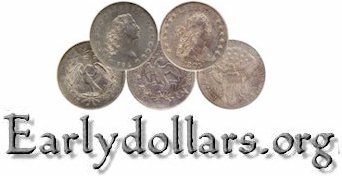

|
Overview: Draped Bust/Small Eagle Dollar Type, 1795 — 1798 |
|
|
Once the Flowing Hair type dollars had entered into circulation, the general public began to express an opinion that the portrait of Liberty depicted her as being “too unkempt” in appearance, and that the portrait should show Liberty as more refined, in keeping with polite society of the time. With the Draped Bust/Small Eagle type, mint engravers answered the public with a completely re-designed image of Lady Liberty on the obverse, facing toward the right, with her hair neatly pulled back toward the left and tied in a ribbon, and with her bust line modestly draped by the folds of her dress. The reverse depicts a re-designed eagle encircled by a wreath comprised of an olive branch to the left and palm leaves to the right. The eagle is now perched upon clouds and holds its wings outstretched. As with the Flowing Hair type, no denomination appears on either the obverse or reverse of the coin. Instead, the edge of the coin bears incuse lettering, reading “ONE HUNDRED CENTS ONE DOLLAR OR UNIT,” with various decorative markings between the words. Draped Bust Small Eagle dollars were minted bearing the dates 1795 through 1798. The dollars of all of these dates are scarce (those dated 1798 being particularly so), but those dated 1795 are generally the most available. Accordingly, collectors seeking a nice specimen of this type will typically select one dated in 1795.
|
|